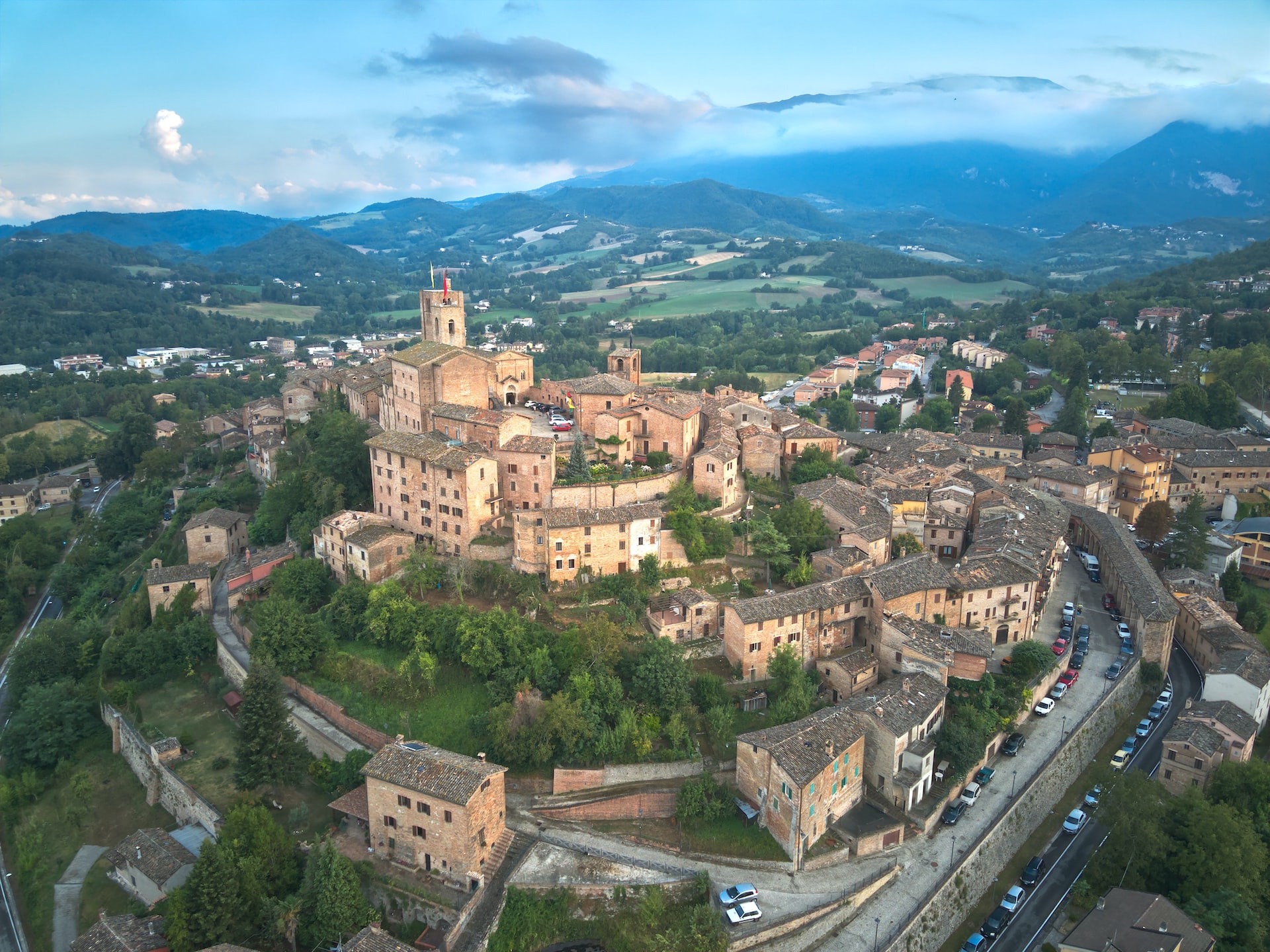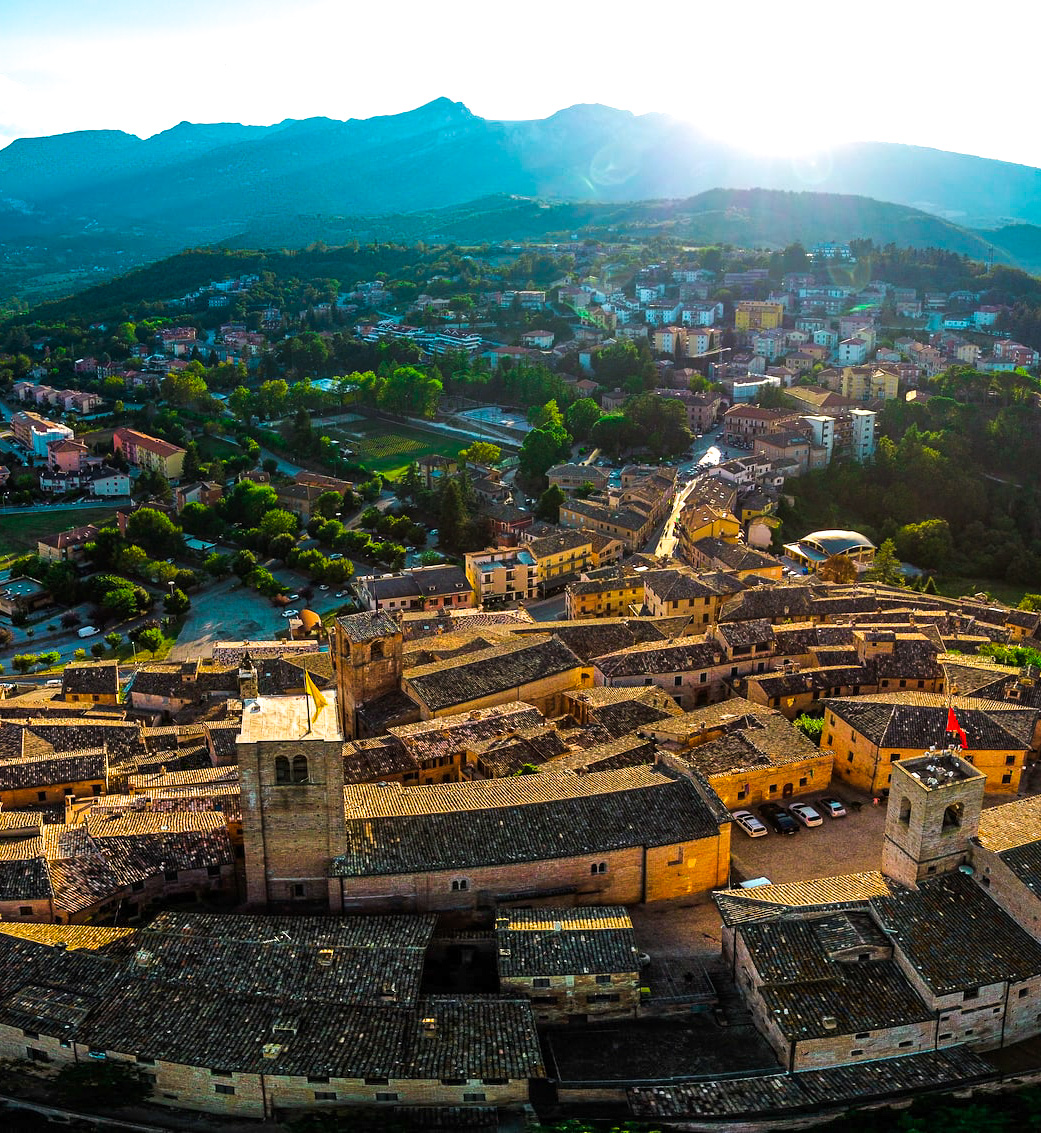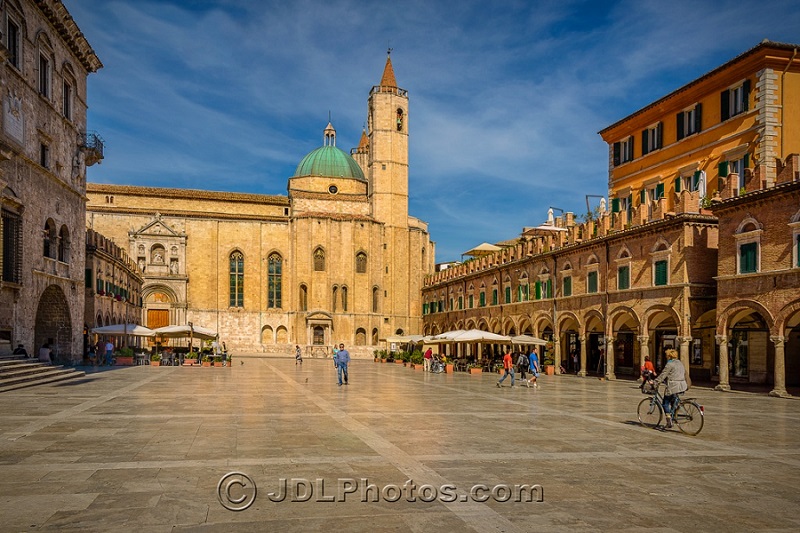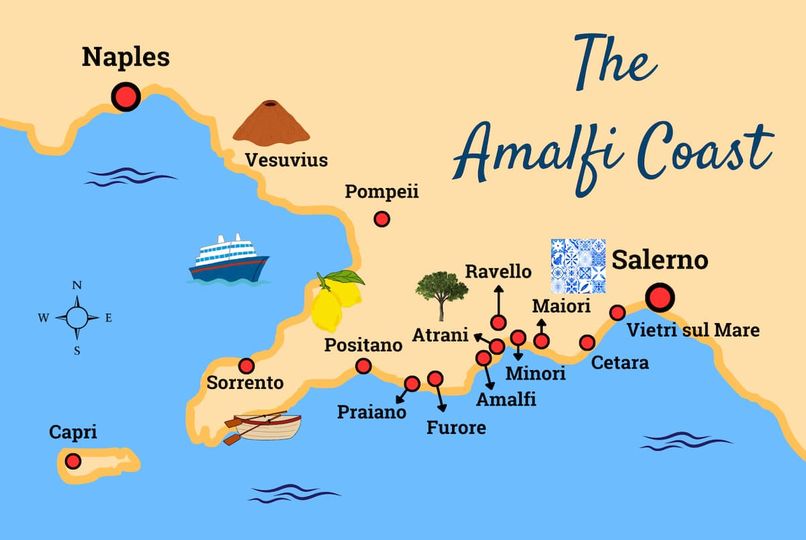This article was kindly shared with us by David Gerstel who lives in Sarnano.
Bags in Time - A Sarnano Tale
Our apartment in Sarnano, Le Marche, Italy, is in the Centro Storico, the historic center, an elongated series of concentric ellipses resting on a stone base. Construction of the hill town began in 1265.

The first buildings were the government building to show civil independence and the church, at the equal, highest, safest point on the hill. After that houses, walls and gates were built to channel traffic and lives. Our building is near but below the Piazza Alta, so it was probably completed in 1350 to 1400 years A.D. The walls of the centro are three feet thick.
Brick gives the town its consistency in appearance, a brownish red from local kilns abandoned centuries ago, leaving only scarred earthen pits. Towns are dated by centuries in Italy or by the Piceno,Etruscan and Roman dominance.
Our apartment was renovated in the 21st century to the new seismic standards and can withstand an earthquake of about 6.5 or higher. It consists of two bedrooms, a living and dining room with kitchen and bath.
 Sarnano by Riccardo Neri via Unsplash
Sarnano by Riccardo Neri via UnsplashThe windows look out at the mountains and a small cortile(courtyard) in which we take our morning coffee and the sun. Only two families share the courtyard. It's the end of the bricked path so it's protected and exclusive.
When you open the windows on the outer wall away from the courtyard, you look down at the next lower narrow lane and buildings and watch neighbors open the shutters in the morning, close them at night, and during the day, observe the inhabitants walk to the stores or sit and speak in small groups on the many weathered benches near the fountains installed in the 1800's.
There are old women who stand at the windows and have a cigarette as they talk, flicking ash that drifts down to the bricks. It reminds me of New York brownstones without stoops. There is a great sense of community.
Milestones in Life
There are other ways to date the world, to mark passages in a personal way. The decades a family owns a building or a house, the number of generations who live together, by earthquakes, wars, and of course the dates of births and deaths of individuals.
In the cantina, the storage basements of the buildings in the centro, you can date the decades since animals were housed for food and burden, the age of the wine thick with dust on the bottles, how long and dry the remnants of wood for fueling the stove and fire. There are events, the autumn the cardinal passed by and led a Palm Sunday procession to the church, the year when Mussolini spoke from the balcony at the Piazza Perfetti arms raised and exhorting Italian supremacy.
The measure of days is not so important as the events which round the life of a town built on a rock with walls to protect inhabitants, honor the wealthy, and repulse the encroachment of strangers. Laws are scribed, but memories become embedded.
More ways. In this town, like many towns and villages, there are monuments to the dead and wounded of the Great War early in the 20th century. Men and horses of bronze, stallions rearing into the air with hoofs flashing and flailing, swords raised and plumed helmets leading the way to slaughter. The names on the pitted tarnished metal of lost, wounded and never found.
There are fewer monuments to the second war, greater in its loss, but after the surrender of Italy to the allies, when partisans fought retreating Germans who exacted terrible retribution, there are plaques and walls with names engraved on buildings and in Piazzas along the streets, the smaller green spaces with a fountain and a pew. There are photos of mostly young men and some women. The dates are fixed in their earnest faces and expressions of joy and determination.
The weapons in the group photos of the dead are always held in affection. The glass that covers the photos is scratched from cleaning. The faces are sometimes obscured with cracks making it hard to see faces.
History Bagged
For me, dating is different, more personal. My wife and I found our newly renovated apartment devoid of the markers and the telltales of history, the penciled lines of age and height. Walls that were clean and wooden stairs without gouges. As we bought, lived in and made our own history, we created a record of the years.
We found a few old bags, stuffed into a heavy cardboard box in the storage that had been cleaned but left alone and in the dark. The electric lights in the cantina had been disconnected or not paid for, and some of the bulbs had been removed or broken in their sockets. Candles would suffice at night, sunlight during the day.
The Italians are frugal and they conserve, they serve the past. You could see the shadow of the box when you opened the double doors with wrought iron clasps and hinges, the thick locking bar into the floor, set against the bricks and stones of a previous millennium.
The first bag we discovered had been made for rice, an early staple of the diet in middle and northern Italy, more than pasta.
This bag was woven cotton, red and white on the label with a outlined young person in red and green. 20 kilos of Priya basmati rice from India, written in Hindi and a star. Two flaps for lifting. I date this bag 50 years. Before that, the culture was closed inward, the war not long behind. Trade and rice would have only begun to come from a far world of half peace.
We brought our world with us when we came to Sarnano in a Steinberg bag from Canada.
“With you a better world”, in English and French, it said. A bold stylized S on a red backround. “100 percent cotton, committed to the environment”, Green circle. Double machine stitching at the top. Stains and dirt not included. I date this bag late 1970's. Steinberg, the supermarket chain, is gone, but the images linger, the memory of the freshest fruit, the sign above the store entrance.
The story and subtle statement on the significance of immigration and refugees preserved in a bag. Success, wealth, dissipation and waste in three generations. A hundred years nearly of life, half the life of the country they inhabited. Why did my wife keep it? Did she know it would travel?
A bag of strong canvas.
Leather straps above a dark brown double thickness bottom, secured by rivets. It might have been military, used to carry ammunition. Short and long handles, the shorter ones cloth wrapped around wire. The long ones to carry on the shoulder are broad to ease the weight. This bag could have been used for wood to fire the open stove or held rocks or potatoes.
I give this bag more age.
You see a man walking slowly, the bag on his back or hip. You feel the strain and taste the sweat, see the discoloration of the cloth bleeding from bag to man. It must have made a man thirsty, walking cobbled streets in the high sun. The fittings had been oiled, the materials are not cracked. Someone cared for this piece. They knew the value, the things they carried.
There is a bag with double grips.
Four feet long, it could have carried a young pig or chickens and geese. Heavy cloth, thick. The handles are hemp or sisal, rough ropes and strong, stretched and worn in the middle, the fibers flattened and smoothed, a few broken strands. Once this bag was tanned. Now it is simply soiled from whatever it held and the floors it sat upon. There are feathers inside and quills, what might be a piece of chipped hoof. I say this bag is old from years when the heavy work was shared by sons. Give it 120 years, 4 generations in the time of man.
An anomaly. A bag brocaded with beads and a strap broken.
Only one with a chatelaine, beads missing, the balance dirty. a decorative belt hook. This carried currency, a handkerchief, jewels.
Once it was fine, but was downgraded over the years past the repairs it shows on the side, threads still visible. A bit of shiny, maybe brass. There are side pockets. Was it a high born family that descended to common and poor, or the bag that aged and was worn?
Was it carried by the matriarch, then handed down to a child as plaything? What has it seen? Did the person who carried it live long enough to see it thrown away or kept as a reminder of years.
Did that person put it in the cantina with the other bags ? We cannot date by years. Maybe by love, departures, decline and death?
Only a few more.
One, a bag for clothes, red, with waved white curves sewed on the body.
Fine grips and a drawstring with toggles, ornate stitches and coloured thread. For a few nights on the road it was something to take on a carriage for a trip to Rome or Florence. Religious items, gifts for the church? Now it is crushed into the stone, age indeterminate, without life. For the sake of our survey, name the popes and choose one you like. It should be one from an age when popes walked or were driven four in hand.
Another. This a bag for three or four books with vellum boards and hand made paper.
Soft black metal right angled strengtheners at the corners and edges. A clasp that allows a small tapered wood pick to act as a lock. The bag is square with an overlapping top, waxed more than once. Only torn remnants of a strap but the inside is still soft.
The bag says, “I protected precious things”.
“What I held went places”, maybe to the palazzo of a wealthy relative. Maybe it was given away after years of service, then used for mementos or toys, also treasures. Patches of the leather have water stains, white and mottled.
Finally, bags of paper and plastic.
Utility satchels with names of stores and addresses, images of food, logos and the markings of world companies. Coloured pale yellow and faded off whites. Old to our eye, but young in the centro. Sharing their destiny with the past in cloth, leather and cotton.
We will add our own bags. I think there will be others, but I do not expect bags that will survive two centuries and many souls. We take the bags and bring them up into the apartment. They will rest in the hallway, settled in a wicker basket from Umbria through and past the mountains between the provinces and different Italian worlds, warmed by the sun on burnished tiles the colour of a late afternoon August day.
We look at the bags and see time. Over months the stains will be removed and damages repaired so the bags may last generations longer. In the end, someone far ahead of us will discard them without feeling.
There is no way to prevent that.
What we feel, they will likely not. What we touch on the surface and below, they may feel indifference. Perhaps I am wrong. Some understanding person could honor and treat the bags with reverence and respect, use and take them to the open vegetable market every Thursday that has been held forever in Sarnano, or to hold flowers or wine.
One can hope, or at least have the dream of hope. All is memory, even the future.
If you enjoy my site, I'd love your support.
All you need to do is book your accommodation via this link or any of the other hotel links on the website. Whether it's for travel to Italy... or anywhere else on earth, your support means the world to us.
You'll get the best deal available, and the income helps us stay independent and keep bringing you the best of Italy.
- HOME
- Italian Stories and Albums
- Sarnano























New! Comments
Have your say about what you just read! Leave me a comment in the box below.